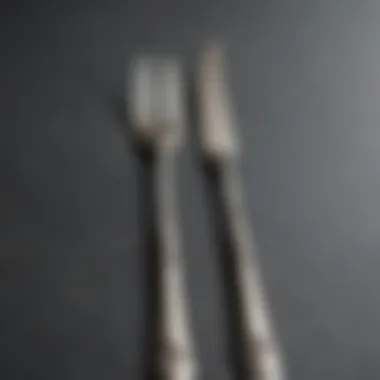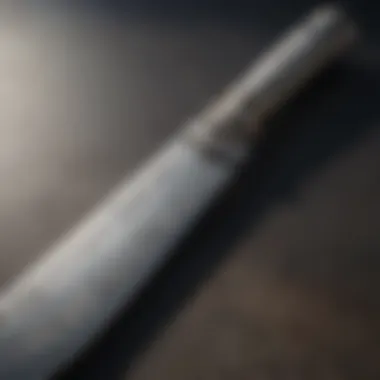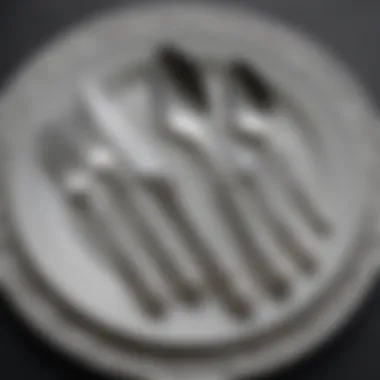Unveiling the True Worth of Sterling Silver Silverware: A Comprehensive Analysis


Rock and Fossil Identification
When examining the worth of sterling silver silverware, it's crucial to delve into the characteristics that define its value. Similar to identifying rocks and fossils, determining the purity and craftsmanship of silverware plays a significant role. Understanding the types of sterling silver, such as 925 silver, also known as 'sterling silver,' and recognizing the hallmarks that denote authenticity are vital aspects to consider. As in rock and fossil identification where specific characteristics indicate quality and rarity, assessing the design intricacies and marks on silverware can indicate its origin and value. Utilizing tools like magnifying glasses to inspect for fine details and markings becomes essential in determining the worth of sterling silverware.
Collecting Tips and Techniques
Beyond understanding the intrinsic value of sterling silver silverware, collecting and preserving these items require careful consideration. To begin, implementing best practices for collecting such as frequenting reputable antique stores or auctions can lead to valuable finds. Locating prime collecting sites may involve exploring estate sales or online platforms known for selling authentic silverware. Safely extracting specimens, in this case, silverware pieces, can be akin to gently handling delicate rocks or fossils to maintain their integrity and value. Techniques such as proper storage in fabric-lined or tarnish-resistant containers are crucial to preserving the luster and longevity of sterling silverware. Creative display ideas may involve showcasing silverware sets in custom-made cabinets or incorporating them into elegant dining table arrangements to appreciate and showcase their beauty.
Preservation and Display
Preserving sterling silver silverware not only maintains its value but also enhances its aesthetic appeal. Techniques for preserving silverware include regular cleaning with non-abrasive solutions to prevent tarnishing and scratching, as similar to caring for precious rocks and fossils. Proper storage methods involve wrapping individual pieces in soft cloth or tissue to avoid scratches and minimize exposure to air and moisture, which can degrade the silver over time. Creative display ideas may range from elegantly arranging silverware sets in a glass-front cabinet to incorporating them into seasonal table settings for special occasions, adding a touch of sophistication and history to dining experiences.
Geological Insights
While exploring the worth of sterling silverware, it is intriguing to draw parallels with geological formations and processes. Just as rocks and fossils hold historical significance, silverware pieces often have stories embedded in their craftsmanship and design. Delving into the historical significance of silverware production and notable discoveries in silver craftsmanship can provide insight into the evolution of dining culture and societal preferences. Understanding the geological insights related to silver mining and refining processes can further illuminate the journey of sterling silverware from raw materials to refined table settings, enriching the appreciation for these timeless utensils.
Introduction
In this article, we embark on a fascinating exploration to uncover the intrinsic worth of sterling silver silverware, delving deep into the age-old question - is sterling silver silverware truly worth anything? This topic is of utmost importance to individuals looking to better grasp the value of their silver utensils, shedding light on various factors that influence their monetary and sentimental significance. By dissecting the essential components that define the value of sterling silver silverware, readers will be equipped with valuable insights that can aid in making informed decisions about their prized possessions.
Defining Sterling Silver
To understand the worth of sterling silver silverware, it is crucial to first grasp the essence of sterling silver itself. Sterling silver is a metal alloy made up of 92.5% silver and 7.5% other metals, typically copper. This composition enhances the durability and strength of the silver, making it suitable for crafting exquisite utensils that stand the test of time. By delineating the unique characteristics of sterling silver, readers will gain a deeper appreciation for the craftsmanship and value imbued in each silverware piece.
Historical Significance
The historical significance of sterling silver silverware stretches back centuries, reflecting the artistry and sophistication of past civilizations. Silverware has long been associated with luxury, wealth, and social status, with elaborate sets gracing the tables of aristocrats and nobility. By exploring the historical context surrounding sterling silver utensils, readers can unearth stories of craftsmanship, design evolution, and cultural influences that have shaped the perception and value of silverware through the ages.
Factors Affecting Value


Sterling silver silverware holds a unique allure for collectors and enthusiasts due to various factors that impact its overall value. Understanding these factors is crucial in determining the worth of silverware pieces, ranging from historical significance to intricate craftsmanship. By delving into the complexities of the market trends and the composition of sterling silver utensils, one can grasp the nuances that contribute to their monetary and sentimental value.
Purity of Silver
When assessing the value of sterling silver silverware, the purity of the silver used plays a significant role in determining its worth. The distinction between 925, 800, and 950 silver marks reflects the percentage of pure silver in the alloy. For instance, 925 silver consists of 92.5% pure silver, making it a popular choice for high-quality silverware due to its durability and resistance to tarnishing. On the other hand, 800 silver contains 80% pure silver, while 950 silver boasts a higher purity level of 95%.
Craftsmanship and Design
The craftsmanship and design of sterling silver silverware are paramount in evaluating its value. The intricacy of patterns in silverware not only adds aesthetic value but also showcases the skill and artistry of the maker. Pieces with intricate patterns often command higher prices in the market due to the labor-intensive nature of their creation. Similarly, artistic elements incorporated into silverware designs, such as filigree work or hand-chased motifs, elevate the overall appeal and desirability of the pieces. Collectors are drawn to silverware that exhibits exceptional craftsmanship and unique design elements, making them valuable assets in any collection.
- Intricacy of Patterns: The level of detail and complexity in silverware patterns demonstrates the expertise and creativity of the artisan, making each piece a work of art. Intricately patterned silverware showcases precision and attention to detail, enhancing its aesthetic appeal and value in the eyes of collectors.
- Artistic Elements: Artistic elements in silverware designs elevate the pieces to a higher level of artistry, attracting enthusiasts looking for pieces that stand out for their uniqueness and craftsmanship. From intricate engravings to elaborate embossing, artistic elements add a touch of sophistication and elegance to sterling silver silverware, making them highly sought-after in the market.
Age and Rarity
As age and rarity are two key determinants of value in the antique and collectibles market, they also hold significance in the realm of sterling silver silverware. Antique silverware pieces, especially those from renowned makers or historical periods, can command premium prices due to their scarcity and historical value. Rarity adds a sense of exclusivity and prestige to silverware collections, making them coveted items for serious collectors and enthusiasts.
Hallmarks and Authenticity
The presence of hallmarks on sterling silver silverware serves as a crucial aspect in verifying its authenticity and origin. Hallmarks not only indicate the purity of the silver used but also provide valuable information about the maker, year of production, and provenance of the piece. Authentic silverware with clear and well-preserved hallmarks carries additional value in the market, reassuring buyers of the piece's quality and heritage.
Market Trends
In the realm of sterling silver silverware, understanding market trends is paramount to gauging the value and desirability of these elegant utensils. Market trends encapsulate the patterns of buying and selling within the market, shedding light on the current demand and potential future worth of sterling silver silverware. By delving into market trends, collectors and enthusiasts can gain valuable insights into the overall landscape of this niche market. This section will explore how market trends play a crucial role in determining the appraisal and resale value of sterling silver silverware, highlighting the dynamic nature of the antique and modern silverware market.
Antique vs. Modern Market
Distinguishing between the antique and modern market segments is essential when assessing the value of sterling silver silverware. The antique market caters to collectors and connoisseurs who appreciate the historical significance, craftsmanship, and rarity of vintage silverware pieces. On the other hand, the modern market caters to individuals seeking functional yet aesthetically pleasing silverware for everyday use. Understanding these distinctions is key to navigating the varied pricing, quality, and demand factors that differentiate the two markets. This subsection will provide a comprehensive comparison between the antique and modern silverware markets, outlining the unique characteristics and factors that influence pricing and consumer interest in each segment.
Collectors' Demand


Collectors' demand serves as a driving force behind the valuation and market dynamics of sterling silver silverware. The preferences, trends, and purchasing behavior of avid collectors significantly impact the prices and availability of sought-after silverware pieces. This subsection will delve into the motivations and factors that drive collectors' demand for sterling silver silverware, emphasizing the role of historical significance, aesthetic appeal, and scarcity in attracting collectors to specific types of silverware. By analyzing collectors' demand, readers will gain a deeper appreciation for the intricate relationship between consumer preferences and the overall market value of sterling silver utensils.
Determining Value
In this section, we delve into the crucial aspect of determining the value of sterling silver silverware. Understanding the worth of your silver utensils is essential in appreciating their significance in the market. By determining value, collectors and enthusiasts can grasp the financial and historical importance of their silverware collections. Recognizing the value of sterling silver items goes beyond mere monetary worth; it embodies a reflection of craftsmanship, artistry, and historical context.
The evaluation of value involves a comprehensive analysis of various factors, including purity, craftsmanship, age, rarity, and market demand. Assessing these elements provides insight into the true worth of sterling silverware. By understanding the intricacies of valuation, collectors can make informed decisions regarding their silverware collections and potential investments.
Moreover, determining value serves as a foundation for appraising silver utensils accurately. This process allows individuals to identify valuable pieces within their collection, distinguishing between common pieces and rare finds. Appropriate valuation also aids in acknowledging the historical and artistic value of sterling silver silverware, contributing to a deeper appreciation of these items beyond their material worth.
Appraisal Process
The appraisal process plays a pivotal role in determining the value of sterling silver silverware. Appraisal involves a meticulous examination of each piece, considering factors such as purity, craftsmanship, condition, and historical significance. Professional appraisers utilize their expertise to assess the authenticity and quality of silver items, providing collectors with an accurate valuation.
During the appraisal process, appraisers may use specialized tools and techniques to evaluate the composition and attributes of sterling silverware. They conduct thorough research to identify hallmarks, maker's marks, and historical context, which contribute to the overall value of the pieces. Appraisers apply their knowledge of market trends and collector preferences to determine the fair market value of silver utensils, considering both intrinsic and extrinsic factors.
Appraisal not only aids in ascertaining the financial worth of sterling silverware but also sheds light on the cultural and historical significance of each piece. Through professional appraisal, collectors gain a comprehensive understanding of their silverware collections, enabling them to make informed decisions regarding acquisition, sale, or preservation.
Professional Evaluation
Professional evaluation is essential in ensuring an accurate and unbiased assessment of sterling silver silverware. Engaging a qualified and experienced evaluator guarantees a thorough and expert analysis of silver items, leading to a reliable valuation. Professional evaluators possess in-depth knowledge of silverware history, craftsmanship techniques, and market trends, allowing them to provide valuable insights to collectors.
By seeking professional evaluation, collectors can benefit from an objective perspective on their silverware collections. Evaluators offer detailed assessments of each piece, highlighting unique features, quality attributes, and historical relevance. Through professional evaluation, collectors can acquire valuable information about the origin, age, and rarity of their silver utensils, enhancing their appreciation and understanding of these artifacts.
Furthermore, professional evaluation ensures transparency and accuracy in determining the value of sterling silverware. Evaluator's expertise and meticulous approach contribute to a reliable and precise appraisal of silver items, enabling collectors to make informed decisions based on expert guidance.
Preserving and Caring
In this comprehensive guide on evaluating the worth of sterling silver silverware, the topic of preserving and caring for these exquisite utensils holds immense significance. Sterling silverware, often passed down through generations or acquired as precious heirlooms, requires delicate handling and maintenance to retain its intrinsic value and aesthetic appeal.


Preservation and care are vital aspects to consider when assessing the worth of sterling silver silverware. Proper maintenance not only prolongs the lifespan of these items but also safeguards their historical and sentimental value. With the right upkeep, sterling silverware can continue to dazzle and serve as elegant representations of craftsmanship and heritage.
Specific Elements:
Preserving sterling silver silverware involves a meticulous approach that includes regular cleaning, appropriate storage, and gentle handling. Neglecting these elements can result in tarnishing, corrosion, or damage to the intricate detailing that makes each piece unique.
Benefits:
By incorporating diligent preservation practices, owners of sterling silver silverware can enjoy items that retain their shine, luster, and beauty over time. Furthermore, proper care ensures that these pieces remain not just functional utensils but also valuable collectibles with the potential for increased worth.
Considerations about Preserving and Caring:
When delving into the realm of preserving and caring for sterling silverware, individuals should factor in the historical value and artistry embedded in each piece. Understanding the craftsmanship behind these items enhances the appreciation for maintaining their pristine condition and securing their worth for future generations.
Cleaning Techniques
Efficient cleaning techniques play a central role in the preservation and care of sterling silver silverware. To uphold the allure and value of these distinguished items, employing proper cleaning methods is paramount.
Storage Recommendations
Equally critical to the maintenance of sterling silver silverware are appropriate storage recommendations. The way in which these items are stored can significantly impact their longevity and condition. Implementing suitable storage practices aids in safeguarding the quality and value of sterling silverware, ensuring that they remain cherished possessions for years to come.
Conclusion
In concluding this in-depth exploration of the worth of sterling silver silverware, it becomes unmistakably clear that this topic holds significant importance in the realm of both historical artifacts and modern collectibles. Understanding whether sterling silver silverware holds any tangible value goes beyond the mere monetary aspect; it delves into the craftsmanship, stories, and market dynamics that bring these pieces to life.
One crucial aspect highlighted throughout this article is the role of purity in determining the value of sterling silver utensils. A higher purity level, such as 925 compared to 800 or 950, not only indicates better quality but also enhances the intrinsic value of the silverware. Additionally, craftsmanship and design play a pivotal role in the worth of these items; intricate patterns and artistic elements can elevate a mere piece of cutlery to a coveted collectible.
Moreover, the age and rarity of sterling silver silverware contribute significantly to its overall value. Antique pieces hold a charm and historical significance that can fetch high prices in the collector's market, while modern creations may appeal to a different set of enthusiasts. The presence of hallmarks and certifications add layers of authenticity and provenance that further elevate the desirability of these items.
Market trends unveil a fascinating narrative of supply and demand, showcasing how collectors' interests can shift over time, affecting the value of sterling silver silverware. The distinction between the antique and modern market provides insight into different collectors' preferences and the unique charms each era of silverware holds.
Appraising sterling silver utensils involves a meticulous process that considers various factors discussed in this article. Professional evaluations can unearth hidden treasures in seemingly ordinary pieces, shedding light on their true worth and historical significance.
To preserve and care for sterling silver silverware is to honor its craftsmanship and ensure its longevity. Understanding the proper cleaning techniques and storage recommendations can prevent tarnishing and maintain the luster of these exquisite pieces for generations to come.







